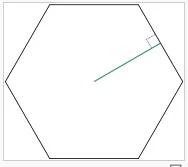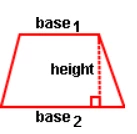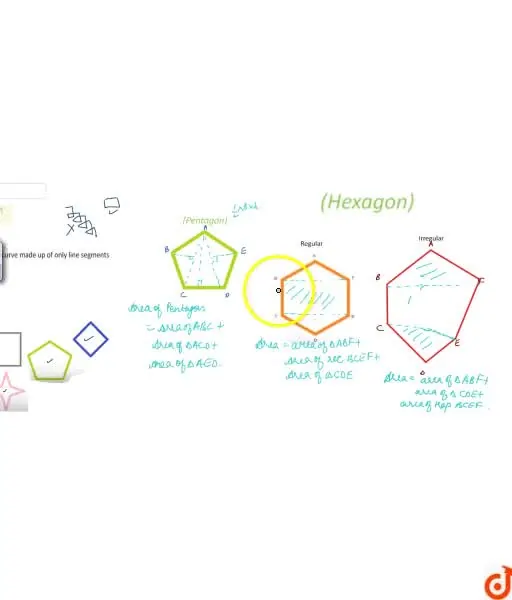Area of a polygon
Area of polygon
Two-dimensional plane shape having straight sides is called a polygon. For example, rectangle, triangle, and pentagon.
On the basis of angle and sides, the polygon is classified into different types.
- Regular polygon
- Irregular polygon
- Convex polygon
- Concave polygon
Regular polygon
A polygon in which all the sides and angles are of equal measure is known as a regular polygon.
Irregular polygon
A polygon having all the interior angle or sides unequal is known as an irregular polygon.
Convex polygon
All the interior angles of the polygon are always less than 180°. In a convex polygon, the vertex will point outward from the centre of the shape.
Concave polygon
In a concave polygon, one or more interior angle is more than 180° .
Parts of a regular polygon
A polygon consists of three parts.
- Sides
- Angles ( exterior, interior)
- Vertices
Area of polygon
All polygons, including pentagon, hexagon, triangle, rectangle, have their own formula for calculating area. We can measure the area of a regular polygon more easily than other polygons.
Area of a polygon formula
There are many formulas to measure the area of polygons some of them are given below for measuring the area of polygons.
Square
A= s² (s = side )
Rectangle
A= lw ( l= length ,w= width)
Equilateral triangle
A= S² √3/4 ( s= side)
Parallelogram
A= b.h ( b = base , h= height)
How to find the area of a polygon?
The formula for finding area of a regular polygon with an apothem is:
area = 1/2 x perimeter x apothem.
Perimeter = sum of the length of all sides.
Apothem = It is a segment that joins all the centre of a polygon to midpoint of the side which is perpendicular to that side.
To find the area of polygon you have to put the above-given formula into the equation.
Area of any Regular Polygon
A normal polygon is where all the sides are the same length and all the angles are equivalent.

Area of polygon with apothem
The apothem of a regular polygon is a line segment from the centre of the polygon perpendicular to the midpoint of one of its sides. The area of any standard polygon is equivalent to half of the product of the apothem and perimeter. '
Area of regular polygon= 1/2 X perimeter X apothem
Area of a Trapezium
The area of a polygon is the quantity of square units inside that polygon. Area is 2-dimensional like a rug or an area carpet.

A trapezoid is a 4-sided figure with one sets of equal sides. For instance, in the graph to one side, the bases are equal. To discover the area of a trapezium, take the sum of its bases, multiply the sum by the height of the trapezoid, and afterward divide the result by 2, The formula for the area of a trapezoid is:
Area of trapezium = ½ (b1 +b2) . h
Each base of a trapezoid must be opposite to the height. In the outline above, the two bases are sides of the trapezoid. Notwithstanding, since the horizontal sides are not opposite to both of the bases, the dotted line is to represent the height of the trapezium.
Related Videos:
- Area and perimeters of various plane
- Various units of measurement of area
- Area of trapezium ABCD
- Volume and Capacity
Polygon type and their properties
Polygon is a two-dimensional structure consisting of an infinite number of straight lines. On the bases of sides or angles polygon divided into various types.
- Trigons
- Quadrilateral Polygons
- Pentagon Polygons
- Hexagon Polygons
- Equilateral Polygons
- Equiangular Polygons
Trigons
These are the polygon with three sides. This is also called a triangle. These trigons are further classified into three categories.
- Scalene Triangle: Scalene triangle is a triangle that has all the sides of different measures.
- Isosceles Triangle: A triangle having two sides equal is known as an isosceles triangle.
- Equilateral triangle: In an equilateral triangle, all sides are equal and each angle is of 60°.
- Quadrilateral Polygon
The polygon shape that has four sides is called a Quadrilateral polygon. These are also called quadrangle. Some of the different types or kinds of this quadrilateral polygon are square, rectangle, rhombus and parallelogram.
- Pentagon
Five-sided polygon is called pentagon polygon.
- Hexagons
The polygon shape having 6 sides and a total of 6 vertices is known as hexagon. The regular polygon will be having a total of 6 equal sides, and all of its interior and exterior angles will have equal measures.
- Equilateral Polygons
The polygon shape that has all the sides of the equal length is called equilateral polygons. For example, some of the equilateral polygons are an equilateral triangle and a square.
- Equiangular Polygons
The polygons having all the interior angles of equal measures, for instance, a rectangle is called equiangular polygons.
What is a regular polygon?
If in a polygon, all the sides and angles are of the same measures, then it is known as a regular polygon.
Vertex is a corner in the polygon. The number of vertex is always equal to sides of the polygon.
Sides are the straight line in a polygon.
Apothem is a line from corner polygon to midpoint of polygon
Radius is a distance to vertex from the centre of the polygon.
Perimeter length of all the sides is equal.
Types of a regular polygon
- If all the sides and angles are of the samemeasures in a triangle, then it is called a regular triangle. The equilateral triangle has 3 equal sides, and each angle of a regular equilateral traingle is 60°.
- If all sides and angles are the same in a quadrilateral then same known as a regular quadrilateral
- If all the sides and angles are equal in a Pentagon, then it is known regular pentagon. It has 5 equal sides, and each interior angle is of 108°.
- If all the sides and angles are the same in n-gon then it is known now as regular n-gon
- Each angle of a regular polygon is calculated by the following formula: S= (n-2)x180°
Here n denotes the number of sides,
and S denotes the sum of all of the interior angles of the polygon.
Important Chapters:


Similar Questions
Find the Area of polygon
View SolutionA circle of radius r is inscribed in a regular polygon with n sides (the circle touches all sides of the polygon). If the perimeter of the polygon is p, then the area of the polygon is
View SolutionIf all the complex numbers z such that |z|=1 and ∣∣∣z¯z+¯zz∣∣∣=1 are vertices of a polygon then the area of the polygon is K so [2k] is equals ([.] denotes G.I.F.)
View SolutionIf all the complex numbers z such that |z|=1 and ∣∣∣z¯z+¯zz∣∣∣=1 vertices of a polygon then the area of the polygon is K so that [2K], ([.] is GIF) equals
View SolutionIf the area of the polygon whose vertices are the solutions (in the complex plane) of the equation x7+x6+x5+x4+x3+x2+x+1=0, can be expressed in the simplest form as a√b+cd, find the value of (a+b+c+d).
View SolutionFind the area of polygon MNOPQR in the given figure if MP=9cm,MD=7cm,MC=6cm,MB=4cm,MA=2cm. NA,OC,QDandRB are perpendicularsto diagonal MP.
View SolutionFind the area of polygon ABCDEF, if AD = 18cm, AQ = 14 cm, AP = 12 cm, AN = 8 cm, AM = 4 cm, and FM, EP, QC and BN are perpendiculars to diagonal AD.
View SolutionQuestion stimulus:-
If one angle of a polygon is 1850, then that polygon is called a ............... polygon.View SolutionIf the external angle of a polygon is 60° then the polygon is:
View SolutionNo. of diagonals of a polygon are 170. No. of sides in this polygon are:
View Solution


